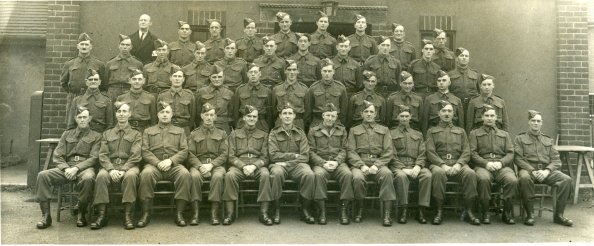
Coach & Horses
|
HARVINGTON IN THE SECOND WORLD WAR
|

There are at least four large concrete bollards surviving from WW2. They were constructed during the war as part of Harvington's war effort. For lifting purposes, each had an iron lifting ring set into the top. The idea was to haul them across the approach roads in an attempt to slow down the advancing Germans.
three either side of the entrance.
The Limes, Shakespeare Lane,
Harvington pill-box is down Anchor Lane near to the ford and weir on the river Avon. It is a well-built in an irregular hexagonal shaped style with the door side being the longest. It is in reasonably good condition, apart from needing a good tidy up. One of the photographs attempts to shew the interior. One can see a triangular brick pillar which was erected both to support the roof and angled to deflect gunfire. Following is a series of photographs taken in March 2015.










Albert Charles (Charlie) Taylor, of Bank Cottage was a member of the ARP & British Legion in WW2, he was also a water bailiffe down by the river.
The only known air raid shelter in Harvington was at The Laurels, were a cellar was improvised.
Military relics: The satellite observation dish near Sheriff's Lench was actually an astronomical camera mounted within the roof of a greenhouse-shaped hut, which was operated in conjunction with a similar set up near Edinburgh; the only two such installations that I am aware of in the UK. Their purpose was to photograph and track the Russian "sputnik" satellite for altitude, velocity and orbital variations. A team of scientists would come out from Aston University on random night shifts. This would have been in the early-to mid-1960's.
I am advised that the site was made obsolete by the development of the Fylingdales VHF scanner in Yorkshire and the RAF tracking station at Muckle Flugga in the Shetland Isles.
Other military relics in the Harvington area include the pill-box guarding the ford at the bottom of Anchor Lane; and examples of anti-tank concrete road blocks can still be seen at the entrance to Ellenden Farm shop, with a similar block outside "The Limes" in Shakespeare Lane. These would have been lifted into position in the event of a German invasion, so forming part of a complex defence network to hinder approaches to the industrial Midlands. David Lee, Grange Lane, Harvington.
Copied from a photograph hanging on the wall of the lounge bar in the Coach and Horses.
Row 1 (rear):
|
Row 2:
|
Row 3:
|
Row 4 (front:
|
Copied from a photograph hanging on the wall of the lounge bar in the Coach and Horses.
Row 1 (rear):
|
Row 2:
|
Row 3:
|
Row 4 (front:
|
"Harvington Firefighters in the War: This photograph shows the 23rd Fire Firce who were based at Harvington Trailers site which became Beoley factory unit, which id now a very pleasant residential area. Anyway they had jhust won the Challenge Cup Light Trailer Pump, Evesham District Cup. You may recognise some faces from the past."

|
Back row: HR Hougham, AH New, H Moulden, LT Wright, R Brewer, J Stephens, W Stanley.
Front row: I A Blotheridge, Col Rowe, CO. W Cartwright, R S Coley. |
This item appeared in the Evesham Journal. From the Coach & Horses collection.

"Three German Prisoners of War who worked on the land for R.L. Brazier & Son 1947 onwards. They were collected from a prison camp situated where Evesham Golf Course is now, top of Craycombe Bank, and returned each night. Later on they were allowed to live out, and set up home together in a large shed, which was where the entrance to Orchard Place is now. Eventually, if they so wished, could return home.
Herbert Dinkle did, but his familylived in the Russian Zone of Germany and was never heard of again.
Hans Thoennisson, married an Evesham girl, Margaret Fell, lived in town, and died Dec. 2010.
Rudolf Weiss married a Swiss girl, living there until his death in 1984. In 2022 Matthias Weiss, the grandson of Rupert Weiss sent an email and explaining what had happened to the three prisoners in the photograph. Rupert had met a Swiss girl over here and they returned to Switzerland to live. In 1995 his family made a pilgramage to Evesham and stayed with Hans Thoennisson one of the prisoners in the photograph. Reproduced here is part of the email.
"My name is Matthias Weiss and I live in Switzerland. Recently, my family and I have talked about my grandmother, who – after WW II – went to England in 1948. She worked as an au pair in a manor somewhere around Evesham. During her stay, she met my grandfather Rudolf Weiss, a German prisoner. After the war ended, he did not know the whereabouts of his family, because they had to flee from their homes. He originally came from a region called Silesia in Germany, which was transferred back to Poland's jurisdiction. With no information on his family, he departed to Switzerland with my grandmother, where they started a family. It was only later when he found out that his family had settled in Hamburg, thanks to the Red Cross. Despite this information, my grandparents decided to stay in Switzerland. As I researched the town of Evesham on Google, I found your website. I was very surprised when I discovered the name Rudolf Weiss on it along with a picture! My grandfather died in 1984; otherwise, everything else in the text is correct. My family and my grandmother went on a holiday to England in 1996, during which also visited Evesham. There, we met Hans Thoennisson with whom we stayed in contact until he passed away."
Photograph and the story are from the Coach & Horses collection.
Another German prisoner, Elmar Gottfield, played football for Evesham.



